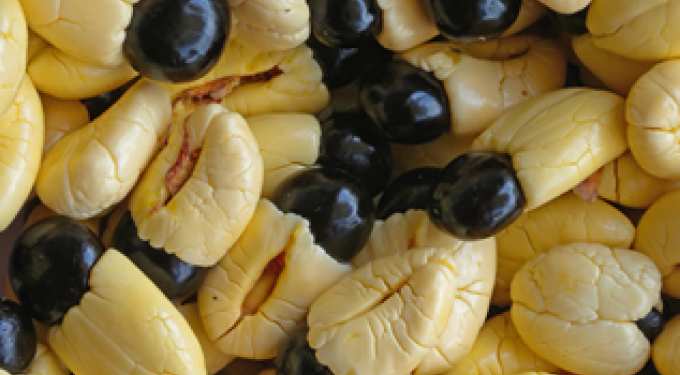Listen up people! The other day someone gave us some ackees saying it was cleaned and ready to go. What a mess! Bits of seed parts were left on and the pink guts were not properly removed. This made us wonder whether Jamaicans are passing these essential skills to younger generations. This is important because poor handling of the fruit often leads to ackee toxicity, referred to as “Jamaican vomiting sickness.”
We want you to enjoy the national dish, but we also want you to stay safe. So here is a quick primer for preparing ackee so you don’t turn it into a murder weapon.
Let us remind you, DO NOT pick ackee unless the pods have opened naturally showing the edible yellow arils inside. Unripe ackee is for sure poisonous. Unu hear? Cooking nah go reduce di poison of di unripe fruit. The seed contains a compound called hypoglycin B that is always poisonous, even in the naturally ripened fruit. The fruits also has a similar chemical called hypoglycin A which becomes safe with exposure to the sun as the pods mature and open. These chemicals in the unripe fruit can lower blood sugar, cause liver damage, induce severe vomiting, and even cause death.
Okay. Now you have your naturally opened pods and a belly rumbling for ackee and saltfish with soft yam and tight flour dumplings. What do you do next?
Look for pods that are firm, with no signs of mold or discoloration. Discard any pods that appear damaged or overripe. When handling ackee, please exercise caution. Ideally, you should wear gloves to be safe, but we have been doing it bare handed since ackee a eat. So just avoid touching your mouth, utensils and surfaces that can result in cross contamination. Wash your hands and all tools thoroughly after cleaning ackee. When cleaning, use a knife to remove the fruit's pink membrane and seeds completely, as these have the highest concentrations of toxins.
With the poisonous parts removed, we are ready to thoroughly wash our ackee. Under gently running cold water rinse individual arils using fingers to ensure all pink membranes and residue and seed bits are removed along with any residual toxins. Once all the arils are individually washed rinse the whole thing a couple more times by filling the bowl with your arils and pouring the water off into the sink. Thoroughly wash the sink and any tools used.
Your ackees are now ready to be cooked. The safest ways to prepare ackee is by boiling it. After removing the seeds and inner membrane, place the washed ackee arils in a pot of boiling water for at least 15 minutes. This helps to neutralize any remaining toxins so the fruit is safe to consume. When cooking ackee, handle with care to preserve its delicate texture and flavor. Avoid overcooking, as this can make the arils mushy and lose their appeal. Your ackee is now safely ready for its dance with saltfish.
Each one, teach one as they say, so please spread awareness about the importance of proper ackee preparation among family and friends. Also share these best practices with fellow foodies so that everyone can enjoy ackee safely and responsibly.
Happy cooking!

